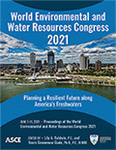Influences of Boulder Placement on Stream Habitat Quality Metrics
Publication: World Environmental and Water Resources Congress 2021
ABSTRACT
Boulder placement is a common method to improve instream degraded habitats. Studies have shown that using boulders, if properly placed, can provide eco-friendly habitats for fish and other aquatic organisms by increasing spatial flow heterogeneity within a stream. This study assessed the effects of boulder placement on the ecological performance of a stream through evaluating habitat quality metrics. Experiments were performed in a gravel-bed flume with and without boulder placement at low and high flow rates. Metrics M1 and M2, representing spatial changes of kinetic energy, and M4, as an indicator of flow recirculation in the horizontal plane, were calculated for each scenario, and their possible effects on habitat quality were discussed. High M1 and M2 values were observed around boulders, specifically in the wake of the boulders. Metric M4 indicated that boulder placement at a low flow rate resulted in the most hydraulic complexity, which may be beneficial for fish and other aquatic organisms. The results can be used to improve stream restoration projects with boulder placement from a habitat quality point of view.
Get full access to this article
View all available purchase options and get full access to this chapter.
REFERENCES
Baki, A. B. M., Zhang, W., Zhu, D. Z., and Rajaratnam, N. (2016). “Flow structures in the vicinity of a submerged boulder within a boulder array.” Journal of Hydraulic Engineering, 143(5), 04016104.
Branco, P., Boavida, I., Santos, J. M., Pinheiro, A., and Ferreira, M. T. (2013). “Boulders as building blocks: improving habitat and river connectivity for stream fish.” Ecohydrology, 6(4), 627–634.
Crowder, D. W., and Diplas, P. (2000). “Evaluating spatially explicit metrics of stream energy gradients using hydrodynamic model simulations.” Canadian Journal of Fisheries and Aquatic Sciences 57(7), 1497-1507.
Crowder, D. W., and Diplas, P. (2002). “Vorticity and circulation: spatial metrics for evaluating flow complexity in stream habitats.” Canadian Journal of Fisheries and Aquatic Sciences, 59(4), 633–645.
Crowder, D. W., and Diplas, P. (2006). “Applying spatial hydraulic principles to quantify stream habitat.” River Research and Applications, 22(1), 79–89.
Dodd, J. R., Cowx, I. G., and Bolland, J. D. (2017). “Efficiency of a nature-like bypass channel for restoring longitudinal connectivity for a river-resident population of brown trout.” Journal of Environmental Management, 204, 318–326.
Goring, D. G., and Nikora, V. I. (2002). “Despiking acoustic Doppler velocimeter data.” Journal of hydraulic engineering, 128(1), 117–126.
Gualtieri, C., Abdi, R., Ianniruberto, M., Filizola, N., and Endreny, T. A. (2020). “A 3D analysis of spatial habitat metrics about the confluence of Negro and Solimões rivers, Brazil.” Ecohydrology, 13(1).
Gualtieri, C., Ianniruberto, M., Filizola, N., Santos, R., and Endreny, T. (2017). “Hydraulic complexity at a large river confluence in the Amazon basin.” Ecohydrology, 10(7), e1863.
Jong, M. C. van Z. D., Cowx, I. G., and Scruton, D. A. (1997). “An evaluation of instream habitat restoration techniques on salmonid populations in a Newfoundland stream.” Regulated Rivers: Research & Management, 13(6), 603–614.
Kozarek, J. L., Hession, W. C., Dolloff, C. A., and Diplas, P. (2010). “Hydraulic Complexity Metrics for Evaluating In-Stream Brook Trout Habitat.” Journal of Hydraulic Engineering, 136(12), 1067–1076.
Lepori, F., Palm, D., Brännäs, E., and Malmqvist, B. (2005). “Does restoration of structural heterogeneity in streams enhance fish and macroinvertebrate diversity?” Ecological Applications, Wiley Online Library, 15(6), 2060–2071.
Martin, V., Fisher, T. S. R., Millar, R. G., and Quick, M. C. (2002). “ADV data analysis for turbulent flows: Low correlation problem.” Hydraulic Measurements and Experimental Methods 2002, 1–10.
Naman, S. M., Rosenfeld, J. S., Jordison, E., Kuzyk, M., and Eaton, B. C. (2020). “Exploitation of Velocity Gradients by Sympatric Stream Salmonids: Basic Insights and Implications for Instream Flow Management.” North American Journal of Fisheries Management, 40(2), 320–329.
Roni, P., Beechie, T. J., Bilby, R. E., Leonetti, F. E., Pollock, M. M., and Pess, G. R. (2002). “A review of stream restoration techniques and a hierarchical strategy for prioritizing restoration in Pacific Northwest watersheds.” North American Journal of Fisheries Management, Taylor & Francis, 22(1), 1–20.
Roni, P., Pess, G. R., Beechie, T. J., and Hanson, K. M. (2014). “Fish-habitat relationships and the effectiveness of habitat restoration.”. U. S. Department of Commerce: Springfield, VA.
Roni, P., Slyke, D. V., Miller, B. A., Ebersole, J. L., and Pess, G. (2008). “Adult Coho Salmon and Steelhead Use of Boulder Weirs in Southwest Oregon Streams.” North American Journal of Fisheries Management, 28(3), 970–978.
Shields, F. D., and Rigby, J. R. (2005). “River Habitat Quality from River Velocities Measured Using Acoustic Doppler Current Profiler.” Environmental Management, 36(4), 565–575.
Shuler, S. W., Nehring, R. B., and Fausch, K. D. (1994). “Diel habitat selection by brown trout in the Rio Grande River, Colorado, after placement of boulder structures.” North American Journal of Fisheries Management, Taylor & Francis, 14(1), 99–111.
Strom, K. B., and Papanicolaou, A. N. (2007). “ADV measurements around a cluster microform in a shallow mountain stream.” Journal of Hydraulic Engineering, 133(12), 1379–1389.
Yu, Y., Yan, Z., and Chang, J. (2008). “Hydrodynamic characteristics of Chinese sturgeon spawning ground in Yangtze River.” Journal of Hydrodynamics, Ser. B, Elsevier, 20(2), 225–230.
Zhu, Z. W., Wang, S. Q., Duan, X. B., Luo, H. W., Chen, D. Q., Sun, M. S., Liu, S. P., and Yu, L. X. (2013). “Studying the variation of cross-section vorticity on the spawning grounds of the four major Chinese carps in the middle reach of the Yangtze River.” Journal of Applied Ichthyology, 29(6), 1463–1467.
Information & Authors
Information
Published In
Copyright
© 2021 American Society of Civil Engineers.
History
Published online: Jun 3, 2021
Authors
Metrics & Citations
Metrics
Citations
Download citation
If you have the appropriate software installed, you can download article citation data to the citation manager of your choice. Simply select your manager software from the list below and click Download.
